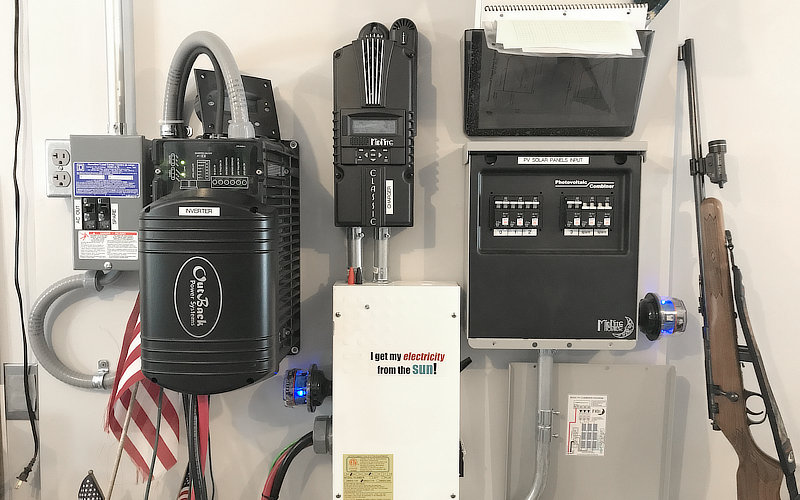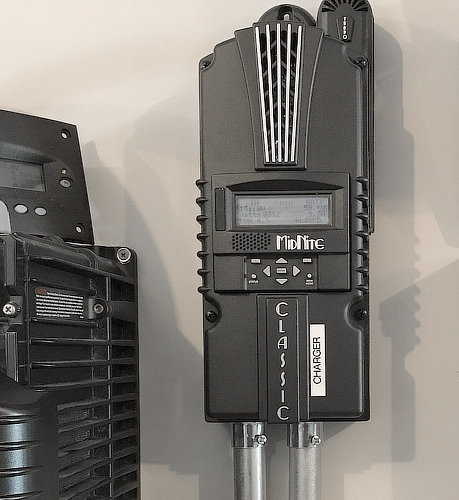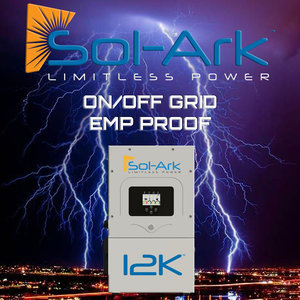What Size Charge Controller Do I Need For Solar Panels?

What size charge controller for a 100 watt solar panel? Or 200w, 300w, or 400 watt solar power system? Or more than that?
(A charge controller installs between the solar panel array and a battery bank)
(description below)
Here’s how to figure out the size charge controller you need (its rating).
I have completely revamped my original post on this. I used a simple hypothetical 300 watt solar panel example to charge a 12 volt RV battery. The concept of how to figure it out will be similar for other solar panel wattage values.
Ready? Lets go…
Every make/model charge controller has their own unique specifications. I know that sounds pretty obvious. But it’s important to match your solar array (which has its own unique output specifications) with the proper charge controller. And it’s important to match your charge controller with the battery or battery bank.
The primary factors that matter most while choosing the right charge controller are:
- the solar array output voltage (volts) under peak conditions
- the solar array output current (amps) under peak conditions
- your battery bank voltage (12 / 24 / 48 ?)
- your battery bank charge amps requirements
The charge controller input specifications (from the solar array) need to be at least able to handle the maximum voltage and current (amps) from your given solar array.
The charge controller output specifications (to the battery or battery bank) need to match the battery voltage, and enough current (amps) to properly charge the battery (batteries).
There’s no one size fits all answer for this. You need to understand the specifications.
I’m going to give you an example, albeit a fairly simple one. This will give you the concept of what we’re doing…
I will use one 300 watt solar panel (actually I have 12 of them in my array, but I don’t want to get complicated here).
Size charge controller for 300w solar panel
Lets say I bought one 300 watt panel to mount on the roof of an RV. This will help charge the 12 volt battery in the RV while off grid or boondocking.
First I choose a 300 watt solar panel. For the sake of this example, I will choose the following. Why? Because while searching for a single 300w panel, I noticed this one which is bendable. Might be ideal for an RV roof!
Bendable Solar Power Module
(view on amzn)
Okay, now lets check the important output specifications:
- Output voltage: 18V
- 300 (watts) / 18 volts = 17 amps
Now I know that I need a charge controller that can handle at least these input specifications.
But what about the charge controller output specs?
I already know one of them, the battery voltage. We will be charging a typical 12 volt deep cell battery. I happen to use the Trojan AGM-31. A typical battery of this particular type is rated for 100 AH (amp hours). In other words, it is the battery energy capacity.
This capacity rating is often specified as the C20 rating. “It is the energy a battery can deliver continuously for 20 hours at 80°F without falling below 10.5 volts.”
In other words, a typical deep cell 12-volt battery that has a C20 rating of 100 AH, means that this battery can deliver 100 amp hours of energy over a 20 hour period.
Why do I say all this? Well, for one, it’s good to know! But secondly, a typical recommended charge rate (amps) for this battery is 20% of C20 during its bulk charge phase. How do I know this? I looked up the specs. on their website.
So this means that ideally the charge controller output would be able to supply 0.2 x 100 amps. Or 20 amps.
Note that this would be (20A x 14.4V), or about 288 watts. (14.4 volts happens to be the recommended bulk charge voltage). So our 300 watt solar panel is perfect for this!
Also note that although in this case a 20 amp charge controller will work, adding at least a 25% margin is even better. Like most systems, you don’t want to run them with “the pedal to the metal” or 100% all the time <grin>.
I would advise a 30 amp charge controller for a 300 watt solar panel system. This provides plenty of margin.
Yet another note… If I had two of these exact 12 volt batteries in parallel (for more capacity), the 20% C20 charge rate would now become 40 amps. So I would want a bigger charge controller, and I would also need another solar panel!
That said, it’s not absolutely necessary. If you don’t beef up the system, the charge time would just be longer instead. This may or may not be a problem for you.
10 amp, 20 amp, 30 amp charge controllers are widely available, commonly used on 12 volt battery systems.
>> Amzn has lots of them
Most common solar pv charge controllers come in 12, 24 and 48 volts.
High power systems will typically utilize 48 volt battery banks to advantage smaller cables and losses than otherwise on lesser voltage battery systems.
There’s more to it than what I’ve described (about choosing a charge controller). However the calculation above is the most determining factor for the rating.
Other factors include:
- MPPT (Maximum power point tracking – the most common) or PWM (Pulse width modulation)
- Temperature compensation
- Ability to charge varying types of batteries
- User adjust-ability of charge parameters
Most manufacturers have sizing tools to help the decision process.
What is a Charge Controller?

My current ~4 KW solar system charger is the Midnite Solar CLASSIC 150 (96 Amps / 48 Volt Battery Bank)
>> view on amzn
It is a device which most importantly properly charges a battery or battery bank, enabling as long a life as possible.
A solar charge controller is designed to receive power from a solar panel or array of panels and use it to charge a battery or bank of batteries.
The charge process is performed in a ‘smart’ or ‘intelligent’ way. This involves varying charge stages, voltages, and current — depending on the type of battery and other factors.
Not to be confused with an inverter, a charge controller is specifically designed to charge batteries in a controlled fashion.
HIGH POWER INVERTER / CHARGE CONTROLLER
If you are considering a higher powered system, such as for an off-grid cabin (or whatever), I highly recommend that you contact Sol-Ark (a sponsor here) who makes excellent Inverter / Chargers! They will be happy to help determine your needs. If you contact them, mention you came from Modern Survival Blog :)
[ Read: The Four Essentials of Off-Grid Solar ]
[ Read: How to measure power consumption – designing a solar system ]

